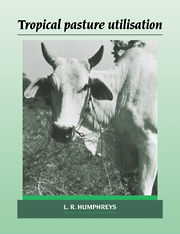Book contents
- Frontmatter
- Contents
- Acknowledgements
- List of abbreviations
- 1 Introduction
- 2 Pastures in tropical farming systems
- 3 Grazing and the environment for pasture growth
- 4 Effects of defoliation on the growth of tropical pastures
- 5 The modification of botanical composition by grazing: plant replacement and interference
- 6 The response of grazing animals to tropical pastures
- 7 Stocking rate and animal production
- 8 Continuity of forage supply: 1. The integration of different pastures
- 9 Continuity of forage supply: 2. Pasture conservation and supplementary feeding
- 10 Systems of rotational, deferred and mixed grazing
- 11 Conclusion
- References
- Index
7 - Stocking rate and animal production
Published online by Cambridge University Press: 23 September 2009
- Frontmatter
- Contents
- Acknowledgements
- List of abbreviations
- 1 Introduction
- 2 Pastures in tropical farming systems
- 3 Grazing and the environment for pasture growth
- 4 Effects of defoliation on the growth of tropical pastures
- 5 The modification of botanical composition by grazing: plant replacement and interference
- 6 The response of grazing animals to tropical pastures
- 7 Stocking rate and animal production
- 8 Continuity of forage supply: 1. The integration of different pastures
- 9 Continuity of forage supply: 2. Pasture conservation and supplementary feeding
- 10 Systems of rotational, deferred and mixed grazing
- 11 Conclusion
- References
- Index
Summary
The choice of stocking rate (SR) determines the level of animal performance, the sustainability of pasture production, and the profitability of the farm enterprise. It is the key management decision whose importance overrides that of other decisions, and schemes of pasture management fail if they are not based on the manager's appreciation of the relationship between the number of stock carried on the property and their individual performance.
Animals compete for the available supply of forage. At low SR animals have ample opportunity for selection, and their effect on each other's performance is minimal. As SR increases, the opportunity for selectivity decreases, and the reduced nutritive value of the diet ingested decreases individual animal performance. As SR increases further the availability of forage of maintenance quality to the individual animal may so decrease that the body condition of the animal falls and a higher incidence of mortality results.
The rates of pasture growth and senescence (Chapter 4) and the botanical composition of pastures (Chapter 5) are sensitive to SR, and the degradation of the environment, as exemplified by high rates of runoff and soil erosion (Chapter 3), result from high SR. The objective is to synchronise animal demand with the level and type of forage supply which will result in the attainment of defined animal production targets. Managers who seek to raise production may increase the forage supply by the removal of competing trees, the replacement of natural grasses by improved, selected grasses, the planting of legumes, the rectification of soil mineral deficiencies and the application of irrigation.
- Type
- Chapter
- Information
- Tropical Pasture Utilisation , pp. 107 - 119Publisher: Cambridge University PressPrint publication year: 1991

